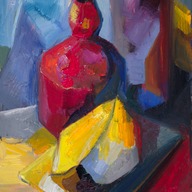| Connections (October 2011 - ongoing) | |||
I have always been wary of the modern art's focus on self: self-expression, uniqueness of self, originality for its own sake. Not that it's not important to speak in one's genuine voice or to have something new to say, but the voice is but a means (not the goal), and the thing to be expressed should not be reduced to self (which would be nice to get rid off completely, but hardly possible). It ought to be about something larger than self, more universal, less fleeting; more interesting, after all. This gallery documents my search for connections to this universality. | |||
|
Just as Pasternak's "burning ochre" image was my beacon in direct painting from life, so this search was guided by Rilke's elegy to Marina Tsvetaeva. We are all waves of the same sea, depths of the sky, we are earth, we are a thousand springs, like larks thrown by the outbreak of song into the Invisibility, – Rilke tells Marina Tsvetaeva in this elegy, one of his last poems. Of course, Rilke is by no means the only one who has expressed this idea, but it was him whom I trusted: I believed that dying Rilke, talking to one of his greatest, and most tragic, younger contemporaries, wouldn't just play with words and metaphors; if he gathered his last bits of life energy to write this, and find those words, he knew what he was talking about. And still, although I had known this poem since my youth, yet only as a painter did I dare to take these words straightforwardly and follow them on blind faith. "Blind", because I did not really, genuinely felt it like this at the time. Come to think about it, I disregarded Rilke's advice to a "young poet" to live the questions, but tried to live his own final answer instead. I probably still don't feel this answer as deeply as Rilke did, but living it, throwing my self into this sea with full abandon, brought me much closer to it. At least, I don't need that blind faith anymore; rather, I now know that he was right. But even an acceptance of this underlying universality leads to a further fork on the road: one path leads back inside oneself, into the depth of one's unconscious; the other, through the perceivable manifestation of this universality, which people tend to call "Art". Whichever path you choose, it might call for another leap of faith: in a subliminal connection of one's soul to the universal, or in the presence of its sublime expression in art. I have chosen the latter, because for me, no leap of faith was needed here: I have known since I can remember myself that this is the essence of art, just as surely as I knew that libraries are repositories of human knowledge. Besides, the idea that you can find it all inside your own head denies the very meaning of art: any material expression of one's findings is pointless, since everyone else would also go into their own heads for their own answers. Technically, this meant engaging works of painting giants with this belief in mind: that we are all waves of the same universal ocean. Some smaller, others huge – but we are but waves in the ocean, not a collection of individual disconnected selves, each imprisoned in their own originality. Because works of art – poetry, painting, music – are like openings to this ocean; they are directly perceptible channels of connection to it, opened for us by the immense power of its greatest waves. This defines the nature of the works shown here (as well as many of my other paintings, sonnet paintings in particular): it is all about the quest for these channels to the universal, for connections between its waves. Each work is anchored both in a specific visual impression of my own and in another painter's vision (sometimes manifested in one of their paintings, sometimes more generally across the body of their work). In other words, each work is an attempt to merge two senses of vision, mine and theirs; to lend my living eyes to their way of seeing, and so to let their powerful waves pass through my mind, wash away my self, and dissolve it in Rilke's universal sea. | |||















